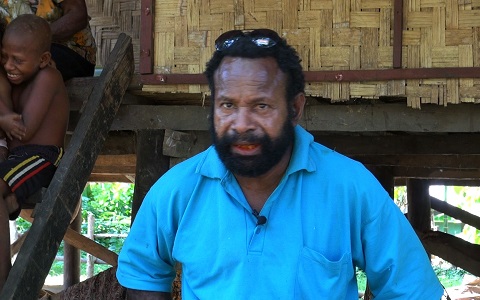It has been 10 years since the Manam volcanic eruption abruptly forced more than 15, 000 islanders to move to Madang province’s mainland.
Many of the families, still living in care centres, have been left destitute with very little fertile land to grow food and little means of generating income.
For 10 years, both the national and provincial governments have ignored the plight of islanders, making no firm decision on their resettlement.
Gabriel Kabarapun is a displaced Manam Islander who has been living in the Asarumba care centre. He built his house in 2004 when they were evacuated during the volcanic eruption and has since changed the sago palm thatch on his roof only once.
Asarumba, like the other Manam care centres, is located on old mission plantations. Building materials are scarce and the islanders are not always allowed to get sago thatch and wood from the traditional land that belongs to the Bogia people.
“I can’t get materials to build a new house,” he says. “The posts are slowly rotting, the walls are falling apart. The owners of the land don’t allow us to use their land to get wood or roofing.”
Because of the scarcity of land and limited resources, it has become increasingly common to find two families sharing one house.
Gabriel shares a house with his nephew. Both men have large families and the house cannot fit them all. This means some family members have use the veranda as sleeping quarters after evening meals.
In 2004, Gabriel and more than 15, 000 people were forced to leave their Island home after the Manam volcano suddenly erupted.
They were placed on the old plantations with an understanding that a long-term solution would be found.
Initially, tons of relief supplies and millions of kina came from both local and international sources. But as donor agencies left one by one, the Manam islanders slipped off of the list of government priorities and were eventually forgotten.
“We are a forgotten people,” says former local level government councillor, Charles Yanda. “If the government can look at foreign asylum seekers, why not pay attention to our needs? We’re Papua New Guineans and we’ve been here for 10 years.”
While there has been much talk about a permanent solution for displaced Manam Islanders, much of it has been political talk with no action on the ground. This is one of the biggest frustrations for Yanda.
“I’ve lost confidence in the government,” says Bogia landowner, Francis Suku. They keep telling us that this issue will be resolved. I’ve seen very little.”
The Manam population in care centres has more than doubled since the evacuation. There are now an estimated 30, 000 people scattered along the Bogia coast, with remnants of village communities on the sheltered part of the island.
The relationship between the islanders and the people along the Bogia coast has not been smooth. Over the years, clashes between Manam and Bogia peoples have resulted in deaths and injuries.
As another decade approaches, the Manams still remain in care centres without a permanent solution. Both the national and provincial governments have not articulated what will become of them.
https://youtube.com/watch?v=85-8vTFIsqk%3Ffeature%3Doembed%26wmode%3Dopaque%26showinfo%3D0%26showsearch%3D0%26rel%3D0


